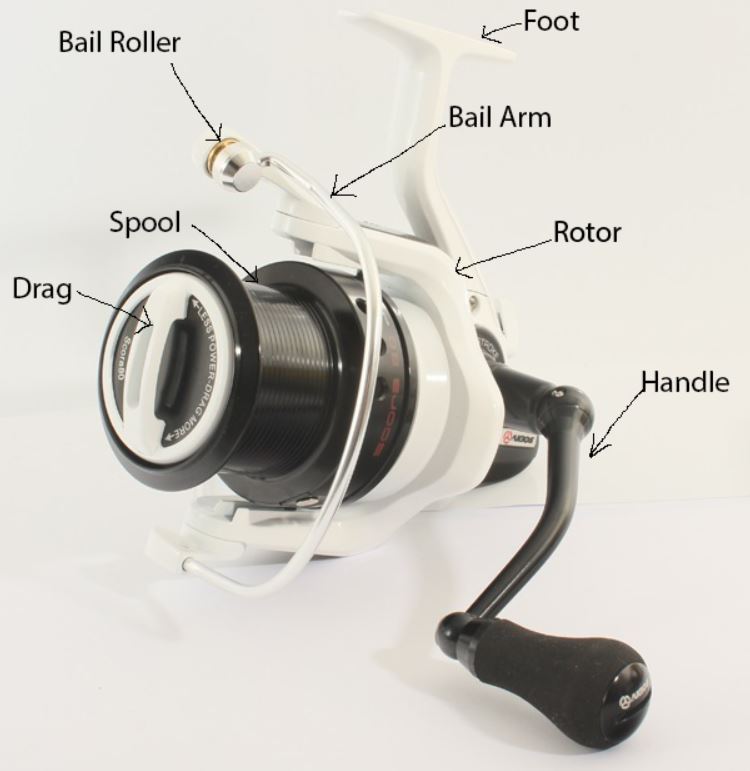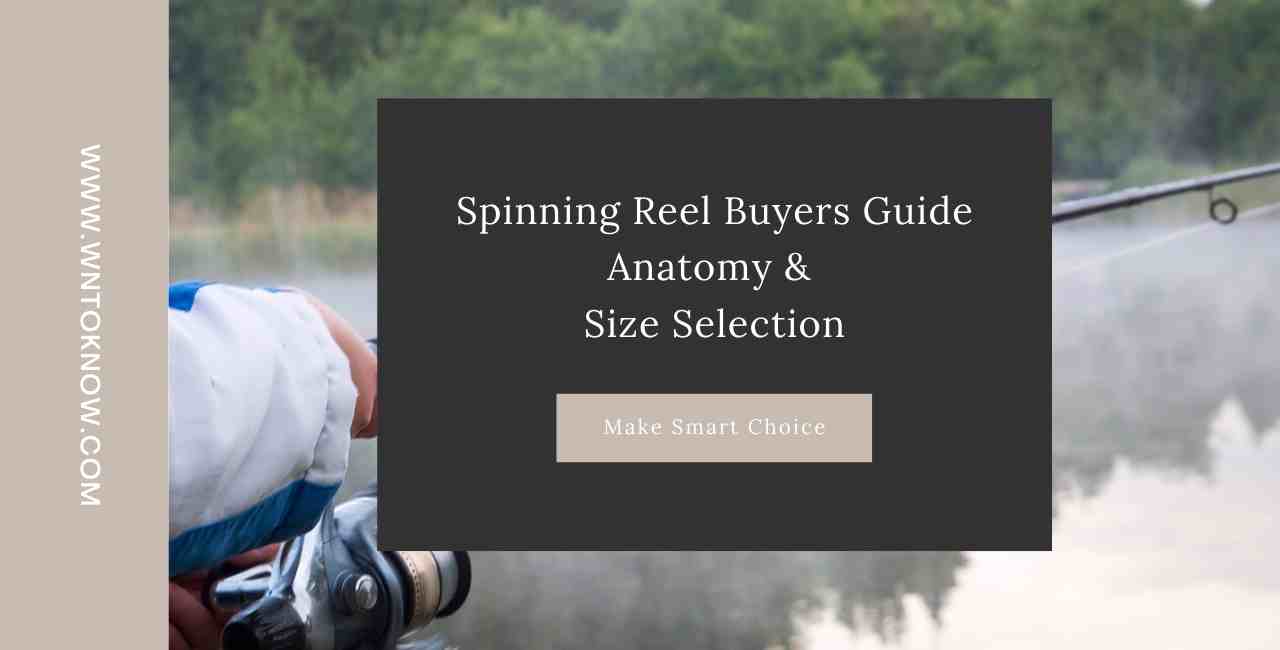In the fishing world, you will find four types of fishing reels: spinning reels, bait casting reels, conventional reels, and fly fishing reels. A spinning reel is one of the most common choices of novice anglers. This is because spinning reels are considered best for casting small baits, but you will also find larger reels for offshore fishing in the ocean. In this spinning reel buyers guide, we are going to understand different body parts of a reel and method of size selection in great detail.
A spinning reel is an open-faced reel with a visible spool. Unlike Baitcasting reels, which are attached on top of the rod, spinning reels are attached to the underside of the rod. This helps anglers to cast more accurately and operate correctly. Since it is mounted below the rod, you need less wrist strength to maintain the position of the reel.
To cast a spinning reel, you need to open the bail. The bail acts as a gate for the line of the spool. When the bail is engaged, it prevents the fishing line from unwinding from the spool. Therefore, you must flip the bail to release the line from the spool. Once you cast the reel, close the bail. After the bail is closed, simply turn the handle clockwise and start reeling the line back in. The handle of the spinning reel works differently. It means, if you rotate the handle once, the spool will rotate more than once. This feature is called gear ratio. For instance, if the gear ratio is 6.1:1, the spool will rotate six times when you rotate the handle once.
Another feature is the retrieval rate that is linked to the gear ratio and spool size of the reel. A lower retrieval rate takes less line; a higher one takes more lines. For example, the Penn Pursuit IV 8000 spinning reel comes with a 44-inch/ 112 cm recovery rate, which means the spools recover 44 inches of line at each turn of the handle.
The common issue with spinning reels is getting a twisted line. If the line gets twisted, you must pull out several feet of line from the spool until it lies flat. Then again, rewind the line ensuring it remains smooth and flat. As we said before, spinning reels are mainly used for small baits, so they can only handle weight under 20 pounds. If you need heavier lures, I recommend you go for Baitcasting reels..
Visible Parts of a spinning reel
Each part of a spinning reel plays a crucial function that you must know before you start your fishing endeavors.

Reel body
A spinning reel’s body can be either plastic, graphite, aluminum, carbon fiber, or magnesium. Since plastic reels are only made for children, you should focus on other materials. For example, aluminum reels are usually preferred due to their durability, affordability, and somewhat light weighted body.
The weight of the reel plays a significant role as it impacts the balance of the rod and the pressure applied on your hand, biceps and forearms while fishing. Lightweight reels offer more balance and control and don’t give you fatigue.
However, you must use a more extensive line size when fishing in saltwater. It would be best to use a bigger line size for a heavier reel made from corrosion-resistant material such as anodized aluminum or carbon fiber.
Line spool
The spool is the part that has the line coiled around it. To cast or retrieve a line, you need to rotate the handle of the spool.
Reel foot
It is the part that you use to mount the reel to the rod. Most rods come with a recessed section, allowing you to slip the reel foot correctly.
Anti-reverse switch
It is a lever located at the bottom of the reel. Turning it On means restricting the spool to go backward, while turning it off allows you to reel in reverse. It is an advanced feature that you will see in a handful of spinning reels. It is quite helpful in situations where you need more time to adjust the drag as you are busy fighting the fish.
Handle
The spinning reel handle is attached to the spool, allowing you to cast or retrieve the line. Most reels come with a reversible handle that you can unscrew and mount on the other side of the reel.
Bail
The bail is the metal wire attached at the bottom of the reel and circulates the spool in a curve form. It acts as a barrier for the line on the spool. You need to flip it before casting. You cannot unwind the line from the spool if the bail is engaged. Its other purpose is to keep the fish in line if it rolls onto your spool.
Drag
The drag control’s location in spinning reels depends on its drag system. in front drag systems, you will find the drag located on top of the spool. The rear drag system is located at the back of the body.
Each drag control has a knob that you can rotate to control the rotation of the reel. It is attached to the spool, so to replace it, you need to unscrew the drag control of your spinning reel.
Choosing the best saltwater spinning reel
Fishing in salt water is significantly more challenging than freshwater fishing. This is because the salt can destroy the metal via corrosion. If saltwater enters the ball bearings of the reel, it can slow down or stop the bearing movements. While any standard metal reel can work in freshwater, you need a solid and sealed spinning reel for fishing in saltwater.
Whether fishing inshore or deep offshore saltwater, you need a spinning reel with a capacity for heavy lures and casting long lines. Because anglers mainly target large fish species in saltwater, power, precision, and balance are all one needs.
The reel size must be according to the line size
Lightweight spinning reels are suitable for smaller reel sizes. However, at saltwater, you need spinning reels with larger line sizes. I recommend you go for reels rated for 6, 8, and 10-pound lines. You can classify spinning reels into four categories: small, medium, large and extra-large.
- Small spinning reels range from 1000 to 3500 (10-35 in some brands). They can handle from 2 to 10 pounds of monofilament line or 4-14 pounds of braid fishing line and are best for targeting smaller fishes like bream, panfish, trout, etc. However, I wouldn’t recommend them for saltwater fishing.
- Medium spinning reels fall between 4000-5500 (40-50) sizes and can handle 8-14 pounds of monofilament and 4-50 pounds of braid fishing line. However, they are ideal for fishing at lakes, bays, harbors, and light offshore boat fishing. You can catch medium-sized fish like largemouth bass, bonefish, cod, walleye, etc.
- Large spinning reels range between 4000 to 5500 (40-50) in size, facilitating 8-14 pounds of monofilament and 30-80 pounds of braid fishing line. It works best for fishing medium to large-sized fishes like carp, snapper, steelhead, and musky. It is ideal for fishing on the beach, coastal off docks, rocks, and boats.
- Extra-large spinning reels range from 10,000-30000 (100-300) sizes that can handle 12-60 pounds of monofilament and 50-100 pounds of braid fishing line. It works excellently on fast-moving water, offshore boat fishing, inshore, and surf for massive fishes like sharks, sturgeon, halibut, and tuna.
The line capacity mentioned in the description of a fishing reel tells you the largest length of line its spool can accommodate. This means, the bigger the reel; the bigger should be the spool. The line capacity is usually weighted as the pound-test weight/length of the line. For instance, a spinning reel with eight pound-test line/140 yards rating means you can also use a 6-pound or 10 pounds line.
Consider the handle, grip, and knob
The handle is an integral part of a spinning reel, as you need some excellent handling skills while fighting a giant fish. A high-end handle with one piece shank offers comfort while cranking without causing any wobbling under heavy loads.
Next, I would focus on the knob of the reel. I recommend the knob be soft but firm. You will find the different qualities of knobs ranging from cork to patented rubber materials. Then I would check the grip of the reel. I prefer a reel that fits perfectly in my palm. It must feel smooth while holding it. Even the slightest friction can cause fatigue.
Choose a wide and shallow spool
The design of the spool not only holds the fishing line but also controls the casting distance while reducing friction while retrieving. Standard spools come in two shapes: wide/shallow or deep/narrow.
The spool lip depth also plays a significant role in fishing. As you start unwrapping, the line hits the spool’s lip. This eventually creates more friction and lowers the cast distances.
I find wide and shallow spools better as they recover more lines while turning the handle. This results in lesser line twists. Plus, a wide spool has a bigger line wrap, so it won’t hit the lip much when you release the line. Go for a wide and shallow spool of popular brands like Shimano Nasci that comes with a titanium spool lip, which is the best in the market.
Go for a better drag system
The drag system is the braking system of the spinning reel. It slows the spool when you are hooked or fighting a fish by applying friction. In the fishing world, the drag system is measured in pounds. Most products mention the maximum amount of drag pressure they can endure. Before the drag system came into existence, stopping a fish from pulling off the line depended entirely on the angler’s wrist strength. The braking system changed the game in fishing by allowing anglers to fight off bigger fish without straining their hands.
There are two types of spinning drag systems available: front drag and rear drag.
The front drag is located on the top of the spool. It comes with large drag washers for better performance and durability. You will find front drag system on most moderate to expensive spinning reels.
The real drag is located on the bottom of the reel. It is easy to access while fighting a fish.
Since fishing in saltwater is a challenge of its own, the front drag system with its large drag washers is the way to go. If you are looking for a saltwater spinning reel with excellent drag systems, I recommend you check out DAIWA Fuego LT, Daiwa Tatula LT, and Penn Spinfisher VI. Read our Best Penn Saltwater Spinning Reels – Shimano vs. Penn for more information.
Check for ball bearings quality
Ball bearings are located inside the spinning reel. They are rotating rings (made of metal or ceramic) that help reduce friction when you release the bail and turn the spool. Ball bearings are located next to pinion gears, which significantly contributes to the smooth function of the reels. The ball bearings capacity in a reel is described as 4+1, 5+1, 6+1, and so on. If it’s 5+1, the reel has five ball-bearing units and one pinion or roller gear.
The role of ball bearings is to make it easier for you to turn the handle. The easier you turn the handle, the less fatigue you feel. More ball bearings in a reel mean more smoothness in movement. At least, that’s what most anglers believe. This is true, but it depends on the quality of the bearings. In truth, a spinning reel with four quality bearings can outperform seven low-quality ones.
Your best bet is to choose a reel with shielded stainless steel bearings. I recommend you go for ceramic bearings, which are specially made for unique environments. Ceramic bearings can work great even submerged in seawater, making them perfect for saltwater fishing.
Shielded stainless steel bearings with a fully enclosed body also work great for saltwater fishing. However, never go for cheap bushings or exposed metal bearings. Bushings are made cheap, resulting in grinding noises and vibrations while reeling.
Always check for gear ratio
As discussed above, the gear ratio determines the number of spool rotations at each handle revolution. The gears inside the reel are essential for reeling, as the gearing is what powers the rotation from the handle to the spool. The gear ratio is described in two numbers, such as 6.2:1.
Reels with low gear ratios are slow but offer more torque for fighting stronger fishes, making them ideal for saltwater applications. I personally recommend a gear ratio of around 4.9:1 for saltwater fishing. The slower retrieval rate helps keep the bait in the hook while you retrieve it.
In general, we recommend a gear ratio of around 4.9:1 for saltwater applications. Here is an opposite example of the musky fisherman. This slower range is excellent for bait rigs since they require a slow retrieve to keep the bait on the hook when you retrieve
Conclusion
I hope I have covered all the information to help you find the best saltwater spinning reel for your fishing game. The last and most important decision is to find the right rod for your spinning reel. Many saltwater fishes, like sharks or marlins, are pretty heavy and wild. This is why you need a heavy and thicker rod in saltwater fishing. I would blindly go for fiberglass rods as they are strong, durable, flexible, and designed to endure rough seas.



